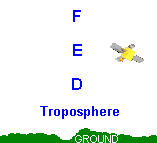



Operating Practices and Procedures
7G1 Recall that satellites orbit the Earth at heights above 250km and understand that most amateur satellites are moving in relation to the Earth and will only be above the horizon at certain times.
There is a great deal to learn about satellite operation before actually trying to operate them and this part of the course only touches on the basics and is not intended as a "How to work satellites" instruction notes.
Satellites have to be a long way from the earth to stay in orbit and are at heights of about 150kms above the earth. Whilst there are commercial geostationary satellites,(they stay in one place relative to the earth), amateur satellites are moving in relation to the earth and will thus only be above the horizon at certain times and often not for very long.

They usually are in and around the "E layer" at 150Kms high.
7G2 Recall that the up-link and down-link
frequencies are generally in different amateur
bands and that details are published by
amateur organisations.
Recall that the transmitting station must be able
to receive both the up-link and down-link signals.
The complexities of a satellite station is much greater than for say a voice station. There is the need for a transceiver on one band for the uplink and at least a receiver on the down link frequency. The reason for this is that you must be able to receive the signals coming from the down link which when you transmit are the uplink signals.
Which frequencies are required for the up and down links are published by amateur organisations.
7G3 Understand that amateur satellites can only be used when they are above the horizon at both the sending and receiving stations, and that the movement of the satellite will cause frequency variation, known as Doppler shift, on the received signal, which must be allowed for when selecting operating frequencies
Trying to work out what stations you would be likely to hear / work will be initially a daunting task as :-
![]() Students may
have difficulty in understanding that the motion of the satellite causes
the frequency to change and hence that the operator would have to change
frequency to keep the transmission audible. So think of it like a passing
police car as it passes the frequency of the note of the two tone horns
changes caused by Doppler shift. Thus as the movement of the satellite
towards or away from the received frequency will change. If you
still do not understand take a length of hose pipe say 3m long and get someone
to swing it around their head and you will hear the pitch of the sound change
as the pipe moves to towards you and then away from you to the pitch is relative
to the CHANGING distance and not the actual distance.
Students may
have difficulty in understanding that the motion of the satellite causes
the frequency to change and hence that the operator would have to change
frequency to keep the transmission audible. So think of it like a passing
police car as it passes the frequency of the note of the two tone horns
changes caused by Doppler shift. Thus as the movement of the satellite
towards or away from the received frequency will change. If you
still do not understand take a length of hose pipe say 3m long and get someone
to swing it around their head and you will hear the pitch of the sound change
as the pipe moves to towards you and then away from you to the pitch is relative
to the CHANGING distance and not the actual distance.
7G4 Understand that satellites have a very limited power supply, derived from solar panels, and that excessive up-link power may result in wasteful and unfair use of the satellite’s power.
The power that the satellite has to operate is very limited as it comes from the solar panels.
The Satellite uses a reciprocal sending system in that a powerful signal on the up link will result in a powerful signal on the down link. However this is very wasteful of power for the satellite and considered unfair to the satellite power supply system.
Only relatively low levels of power need to be used as the VHF and UHF uplinks easily reach the satellite (so long as the aerial is pointed in the right direction). As with all radio operation it is better to use a good antenna system than higher power as the good antenna system will give you both better TX and RX capabilities.
The origin of some of the text on this page is from the RSGB with additions by the web master